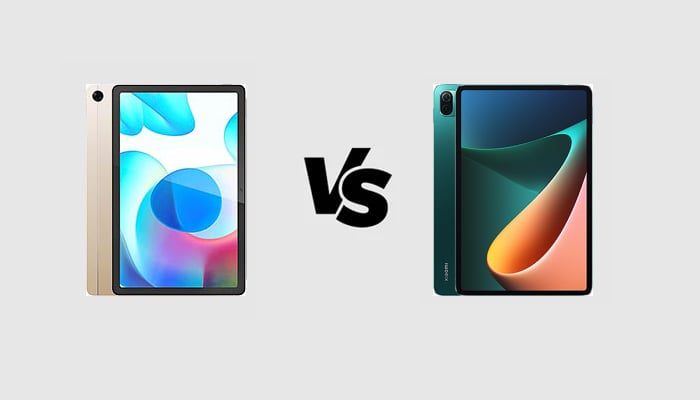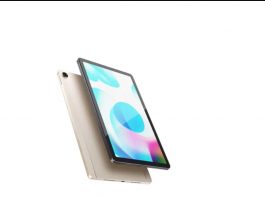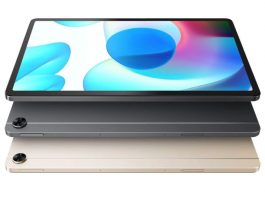Unlike what the first rumors suggested, Realme decided to debut in the tablet market by launching an affordable model instead of a flagship. This is the reason why it can not compete with the latest Xiaomi tablets: the Mi Pad 5 and the Mi Pad 5 Pro. It has inferior specifications, but on the other hand, it belongs to another price range which is much more interesting. A lot of people are wondering if getting a Realme Pad is enough for their needs or opting for an advanced device like the Xiaomi Mi Pad 5 may represent a more valid option. That is why we decided to compare the specifications of the Realme Pad and the Xiaomi Mi Pad 5.

Realme Pad vs Xiaomi Mi Pad 5
| Realme Pad | Xiaomi Mi Pad 5 | |
|---|---|---|
| DIMENSIONS AND WEIGHT | 246.1 x 155.9 x 6.9 mm, 440 grams | 254.7 x 166.3 x 6.9 mm, 511 g |
| DISPLAY | 10.4 inches, 1200 x 2000p (Full HD+), IPS LCD | 11 inches, 1600 x 2560p (Quad HD+), IPS LCD |
| PROCESSOR | MediaTek Helio G80, octa-core 2 GHz | Qualcomm Snapdragon 860, octa-core 2.96 GHz |
| MEMORY | 3 GB RAM, 32 GB – 4 GB RAM, 64 GB – micro SD dedicated slot | 6 GB RAM, 128 GB – 6 GB RAM, 256 GB |
| SOFTWARE | Android 11 | Android 11, MIUI |
| CONNECTIVITY | Wi-Fi 802.11 a/b/g/n/ac, Bluetooth 5.0, GPS | Wi-Fi 802.11 a/b/g/n/ac, Bluetooth 5.0, GPS |
| CAMERA | Single 8 MP 8 MP front camera |
Single 13 MP f/2.0 8 MP f/2.0 front camera |
| BATTERY | 7100 mAh, fast charging 18W | 8720 mAh, fast charging 33W |
| ADDITIONAL FEATURES | Optional LTE | Pen support, keyboard support |
Design
The Xiaomi Mi Pad 5 has a more attractive design because it comes with a higher screen-to-body ratio. The display covers a bigger part of the front panel, while the Realme Pad has thicker bezels. On the other hand, the Realme Pad is more compact, that is the reason why it may be more interesting for those who want to use it in mobility. The thickness is practically the same: 6.9 mm, while the Realme Pad is lighter with a weight of 440 grams. Both the tablets are built with an aluminum back and an aluminum frame, but the Xiaomi Mi Pad 5 offers additional features making it more similar to a PC. You can attach a keyboard to the Xiaomi Mi Pad 5 and it even supports a stylus for handwriting and drawing, while you do not get these features with the Realme Pad.
Display
Both Realme Pad and Xiaomi Mi Pad 5 are equipped with an IPS display, but the IPS panel of the Xiaomi tablet is superior to the Realme Pad. Besides having a wider diagonal (11 inches vs 10.4 inches), it is able to show one billion colors and it supports a 120 Hz refresh rate. And that is not all: there are also the HDR10 certification and Dolby Vision support to improve the image quality. Xiaomi Mi Pad 5 has an IPS panel, but the image quality is closer to an OLED display. Even the resolution is higher (2K vs Full HD). As already mentioned, the display of the Mi Pad 5 supports a stylus, thanks to an active digitizer. The Realme Pad has four stereo speakers and a 3.5 mm audio jack, while you get just four stereo speakers with the Mi Pad 5.
Specs & Software
If you need the max performance because you want to use the tablet with heavy apps or for gaming, you must go for the Xiaomi Mi Pad 5. It is powered by the Snapdragon 860 mobile platform which belongs to the high-end segment as it is close to the Snapdragon 865 in terms of CPU and GPU performance. The chipset is paired with 6 GB of RAM and up to 256 GB of UFS 3.1 internal storage. Realme Pad is pretty disappointing for power users because it has a low-end Helio G80 chipset, but it is still a good chipset for the average user, paired with up to 4 GB of RAM and 64 GB of storage. Realme Pad also comes with a special version of Realme UI called Realme UI for Pad and is optimized for tablets, while Xiaomi Mi Pad 5 has the classic MIUI you can also find on Xiaomi phones. Note that Realme Pad has a 4G variant, while Mi Pad 5 only comes with WiFi.
Camera
With the Xiaomi Mi Pad 5, you get an entry-level camera, but it is a superior camera to the Realme Pad: we are talking about a 13 MP rear sensor that is able to record 4K videos. The Realme Pad has an 8 MP rear camera that records videos in 1080p resolution at 30 fps.
- Read More: Xiaomi Mi Pad 5 & Mi Pad 5 Pro Official: 11″, 120Hz refresh rate, 5G, MIUI for Pad & more!
Battery
The Xiaomi Mi Pad 5 is bigger, so you should have already expected a bigger battery. The tablet has an 8720 mAh battery with 33W fast charging, while Realme Pad has just 7100 mAh and 18W fast charging, but it still provides a good battery life.
Price
Xiaomi Mi Pad 5 carries a €260/$307 starting price in China, while Realme Pad costs just €160/$189 in its base variant. The Xiaomi Mi Pad 5 wins the comparison, but if you are not a power user and you do not mind about its pros, Realme Pad may be enough for you. Which one would you pick?
Realme Pad vs Xiaomi Mi Pad 5: PRO and CONS
Realme Pad
PRO
- More affordable
- More compact
- Optional LTE
- UI optimized for tablets
CONS
- Inferior hardware
Xiaomi Mi Pad 5
PRO
- Bigger battery
- Better hardware
- Superior display
- Better camera
- Keyboard and stylus support
CONS
- No cellular connectivity
RELATED
- Redmi K40 vs Motorola Edge S: Specs Comparison
- Redmi K40 vs K40 Pro vs K40 Pro+: Specs Comparison
- Samsung Galaxy S21 Ultra vs Note 20 Ultra vs S20 Ultra: Specs Comparison
- Realme GT Master Explorer vs OnePlus Nord 2: Specs Comparison



